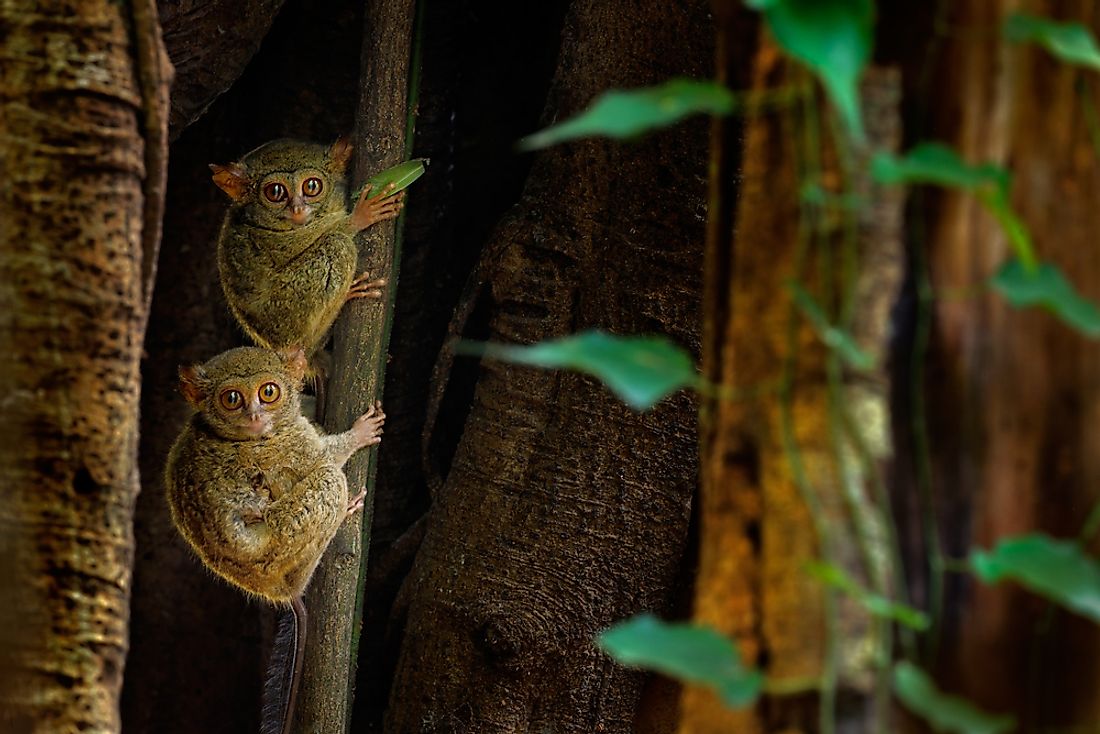How Many Species Of Tarsiers Are There?

Tarsius is a genus of small primates belonging to the Tarsiidae family. All members of this genus are found in the Indonesian island of Sulawesi or nearby islands. Tarsiers are carnivorous by nature. Insects are their main food source.
Peleng Tarsier
The Tarsius pelengensis is found in the Peleng Island off the southeast coast of the larger island of Sulawesi in the Indonesian province of Central Sulawesi. It is known for its owl-like ability to turn its head 180 degrees. Since its eyes are fixed in their sockets, head movement is necessary to see sideways. It has been labeled as Endangered by the IUCN.
Wallace's Tarsier
The Tarsius wallacei is a Tarsier species that has been only recently described in 2010. Two populations of this species are found in the Central Sulawesi forests separated by the city of Palu Bay. Although morphologically it is quite similar to other Tarsier species, it has a distinctive duetting call and some genetic uniqueness in its Y-chromosomal DNA and mitochondrial DNA. The Wallace's tarsier has big eyes, white spots behind the ear, and a distinct facial mask. It has yellowish-brown fur and its throat is copper colored. It is believed that the population of this species is rapidly declining but as its numbers have not yet been evaluated, the IUCN describes it as Data Deficient.
Siau Island Tarsier
The Tarsius tumpara is a tarsier species found in an extremely secluded habitat in the tiny volcanic island of Siau in the Sangir Archipelago in the North Sulawesi province of Indonesia. Deep oceanic waters separate this island from the other around it. Due to this seclusion, the Siau Island Tarsier exhibits high levels of endemism. Its restricted range makes it vulnerable to extinction and thus, it has been classified as Critically Endangered by the IUCN.
Spectral Tarsier
Tarsius spectrum is another species of the Tarsier genus. It is found in the Selayar Island in the South Sulawesi province separated from the main island of Sulawesi by the Selayar Strait. It is the type species of its genus. The species has been labeled as Vulnerable by the IUCN.
Sangihe Tarsier
The Tarsius sangirensis is found on the Sangir Island of Indonesia. This island is located to the east of Sulawesi Island. The Sangihe tarsier prefers to live in primary growth forests but can also adapt itself to secondary growth forests. This species has by big round eyes that are pale-chestnut colored. It weighs only around 100 to 120 g. It has a yellow-brown and dullish-white upper pelage and lower pelage respectively. The Sangihe is unique with respect to its tail that has a sparse covering of dorsal fur. It also does not have scales below its fur. It also has a unique call. It feeds only on animal matter, especially insects like beetles and grasshoppers. The species has been labeled as Endangered by the IUCN.
Dian's Tarsier
Tarsius dentatus is another Tarsier species that is endemic to central Sulawesi in Indonesia. It is a nocturnal animal that lives in the primary, secondary, and mangrove forests on the island. It weighs around 11.5 to 12 cm. It also has a strict animal diet like the other tarsiers. The tarsier is also threatened by habitat destruction and hence, is classified as a Vulnerable species by the IUCN.
Tarsius Fuscus
This tarsier species is found in the Sulawesi Island’s southwestern peninsula. The taxonomy of this species has been confused for long. This species has a reddish-brown fur and black hair at the tail end. The hind feet of this species is shorter than that of the others while the tail is also shorter compared to body size than most other species. It is insectivorous and arboreal by nature. The population of this species has not yet been documented by the IUCN.
Lariang Tarsier
The Tarsius lariang is found in Sulawesi Island’s western section. The species is named after the Lariang River that flows near the place where populations of this species occur. It is distinguished from other tarsier species by its darker grayish-brown fur. This animal also has a clear dark ring surrounding its eyes. It is also the second largest tarsier species. The population of this species is yet to be determined and it is described as Data Deficient by the IUCN.
Pygmy Tarsier
The Tarsius pumilus is a nocturnal primate living in central Sulawesi Although believed to be extinct in the early 20th century, the species was rediscovered in 2000 by Indonesian scientists. The pygmy tarsier is about 4 inches long and weighs less than 57 g. As the name suggests, the pygmy tarsier is smaller than other tarsier species and also has smaller ears. It has a tan or buff colored fur.
Newest Species Of Tarsier
Two new species of tarsiers have been described as recently as 2017. These are the Gursky's spectral tarsier and the Jatna's tarsier. Both are found in Indonesia but further in-depth studies about the population of these tarsiers are yet to be completed.
Threats To The Tarsiers Of Indonesia
The biggest threat to the survival of the tarsiers of Indonesia is habitat loss and climate change. Since these animals have a highly restricted habitat, any changes to the same due to human interference can be highly dangerous. The growing populations in Sulawesi and the nearby islands and the destruction of forests to create space of agricultural activities and human settlement are pushing the tarsiers into smaller and smaller spaces. Sea level rise due to climate change also threatens to destroy tarsier habitat.







